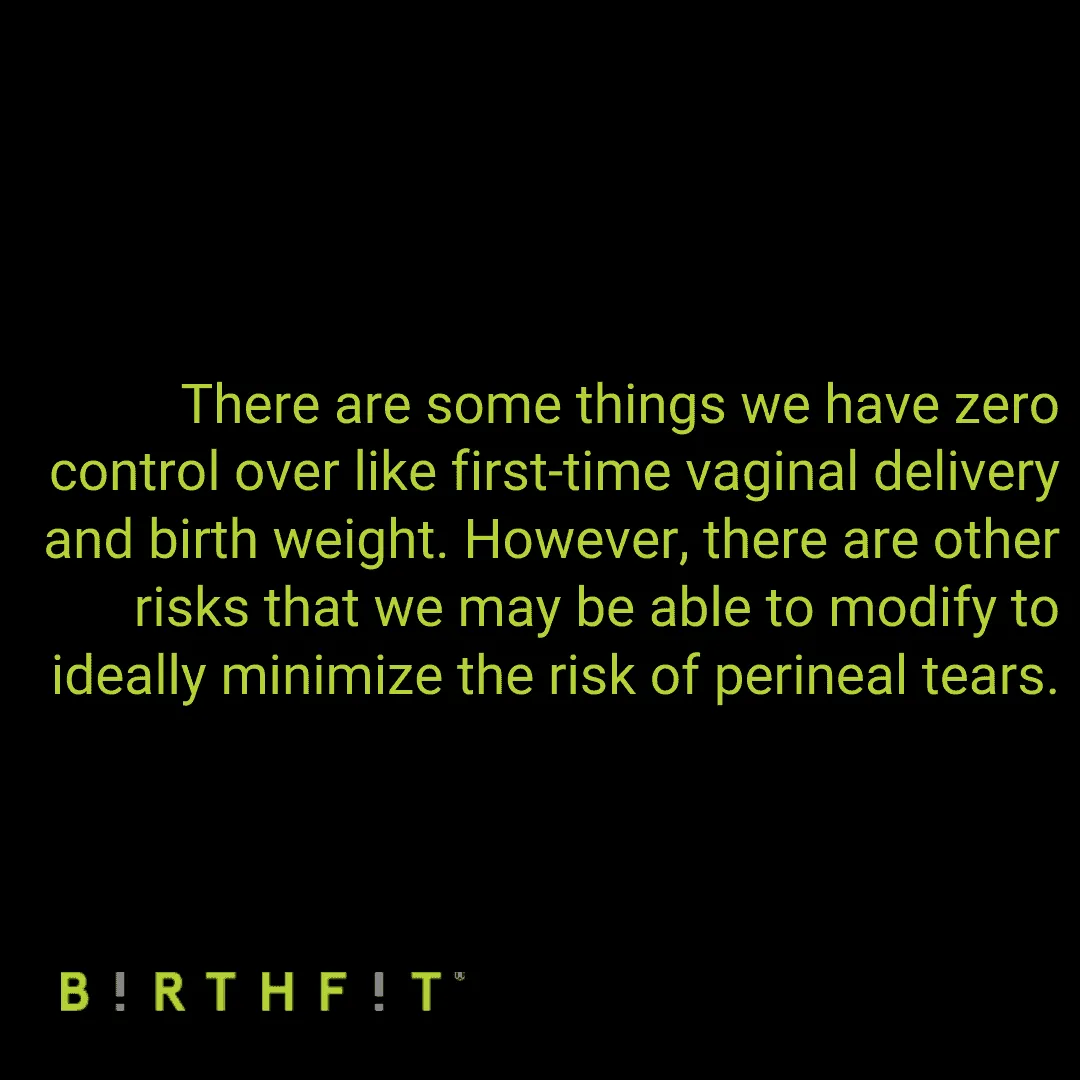The thought of perineal tearing causes shivers to run down most mama’s backs.
The perineum is the area between the vaginal opening and the anus that sometimes tears during labor. In fact, 53-79% of women who have a vaginal delivery will have some type of tearing or laceration to the perineum. Depending on where you look, some studies say that as little as 10% of first-time moms will have zero tearing, while 31% of second-time mamas will deliver vaginally without tears.(1) Tearing during birth can occur to the perineum, anus (where you have a bowel movement), urethra (where you pee), or other parts of the vulva, including the labia.
What do we know about why perineal tears happen?
Perineal tearing or lacerations occur as the perineum and the rest of the vulva stretch to allow for the passage of the baby’s head through the vagina. There are a few studies that have shown several factors that may increase the likelihood or severity of perineal tears:
- First vaginal delivery – Moms who are having their first vaginal delivery are more likely to tear than if they have previously had a child vaginally. This is also an important note because research has shown that just because a mama tore during an earlier pregnancy does not mean she will tear this time or have the same severity. In fact, 95% of mamas with a previous severe tear will not have another.
- Long Second Stage of Labor – The second stage of labor is often called the pushing phase when the cervix is fully dilated and ends when the baby has arrived.(1)
- Forceps – The use of forceps during delivery has been shown to result in an increased risk of third and fourth-degree tears.(1)
- Occiput Posterior Position – This is often called a sunny side up baby and means that the back of the baby’s head that is bony is rubbing on mama’s back. If you suspect an OP baby, check out Spinning Babies for exercises and guidance to help.(1)
- Heavy birth weight – There are a few studies that have linked “heavier” birth weight (over 8.8 lbs) to increased risk of tears. However, it’s important to note that late-term ultrasounds are often not reliable in determining body weight and this increase was heavily linked to the next three risks.(6)
- Hospital Delivery with OB – A few studies have shown that the training providers receive may impact the rate of intact perineum. In fact, one study showed that 31.9% of women with OBs have an intact perineum while 56-61% of women under midwifery care had an intact perineum following birth. Furthermore, 42% of the tears with OBs required suturing while only 35-37% with midwives required repair.(7, 9, 10, 13)
- Pitocin – Pitocin is the synthetic version of oxytocin, the natural hormone that causes the uterus to contract. During unmedicated labor, oxytocin naturally increases in response to the baby applying pressure to the cervix and the pelvic floor. Oxytocin works with other hormones including catecholamines to help push the baby out. For more information on the effects of pitocin, oxytocin, and catecholamines, this is an excellent blog by Dr. Sarah Buckley.(7)
- Epidural – This one has mixed risk in research. It’s a chicken or the egg scenario. The reason is that many women who receive epidurals are first-time vaginal deliveries, the mother was induced or had Pitocin to augment labor, the second stage of labor was long, there was an instrumental birth, or the mother received a midline episiotomy. All of these inherently increase the risk of perineal tearing on their own so it is unknown if the epidural is truly a risk for increased perineal tears or if it is these confounding factors.(7, 20, 21)
- Shoulder Dystocia (when the baby’s shoulder gets stuck inside the pelvis) – This is another maybe, maybe not situation. One study highlighted that shoulder dystocia does not increase the risk of tearing but is related to OASIS or obstetrical anal sphincter injury. OASIS often results in anal incontinence, recurring urinary tract infections, and pelvic pain.(7, 22)
Is there anything we can do to minimize the risk of perineal tears?
There are some things we have zero control over like first-time vaginal delivery and birth weight. However, there are other risks that we may be able to modify to ideally reduce the risk of tears.
- Position/Movement – The stereotypical position we see a woman giving birth on TV is called the lithotomy position – on her back, feet in straddles, knees up, and pushing. The lithotomy position results in the highest rate of tearing.(6,7) There are other birthing positions, such as a mother being on all-fours or lying on her side, that have the lowest rate of tearing.(7, 9, 10) Other positions that have been shown to decrease the incidents of tearing compared to the lithotomy position are kneeling, standing, squatting, and sitting on a seat.
- Avoid “Routine Episiotomy” – Per ACOG, data shows no immediate or long-term maternal benefit of routine episiotomy in perineal laceration severity, pelvic floor dysfunction, or pelvic organ prolapse compared with restrictive use of episiotomy. However, if an instrument-assisted delivery is needed, a medio-lateral episiotomy can prevent OASIS.(1,14)
- Perineal Massage and a warm compress – Perineal massage during pregnancy can be beneficial to help mama prepare mentally and physically for labor. Perineal massage during pregnancy does not have conclusive evidence to support its use to reduce tearing; however, many women have noted they feel more confident and comfortable in their bodies by doing perineal massage. During the second stage of labor, perineal massage and warm compresses by the provider may reduce third and fourth-degree tears.
- “Rest and Be Thankful” – Sheila Kitzinger identified an additional stage of labor she coined, “Rest and be thankful”. This is the stage of labor when the cervix is fully dilated, the baby has descended and contractions may slow or stop. If left alone, these contractions usually reemerge when the mother and baby are both ready for birth. This helps delay the pushing stage of labor and decreases the time and energy the mother spends pushing.
- Slow delivery of infant’s head and instructing mother to not push during delivery of head – These often go hand-in-hand during delivery. The TV stereotypical pushing (coached pushing or purple pushing) is when a laboring mother is told to “hold your breath and then push as hard as you can for 10 seconds and do this three times in a row.” Mothers that are left alone during birth may experience the fetal ejection reflex when they are not instructed to push during delivery but instead naturally breathe or blow the baby out.(4,5,12,16)
- Birth Team and Support Team – This one is important, more because of the other risk factors listed above. Will your provider support you while you move during labor or are there restrictions that require you to lie on your back? Is your provider comfortable with applying warm compresses or performing perineal massage? Does the location you are birthing at or your provider restrict the amount of time you can be fully dilated before pushing? What is your provider’s episiotomy rate? If you were to tear, do you still feel supported by your provider? Although one of the “risk factors” is giving birth in the hospital with OBs, there are still AMAZING providers out there who support a mother’s desire to move, breathe the baby out, provide moist heat, and perineal stretching, as well as help with slow descent of the baby. “How women are cared for during their labor, birth and the postnatal period has a direct impact on how they process, understand, and rediscover a new sense of self following severe perineal trauma.”(15)
I wish that everything I listed above was a to-do list you could just check off and everything would be perfect. Unfortunately, life and birth are often full of curveballs. The biggest thing I can recommend is that you find a provider and doula that you trust so if the time comes that you need to transfer locations or divert from your birth preferences, you still feel heard and trust those who are supporting you.
Lauren Keller, DC, DABCA
Elemental Chiropractic, Inc @mamaspelvicfloor
References:
- https://www.ncbi.nlm.nih.gov/pmc/articles/PMC3599825/
- Harkin R, Fitzpatrick M, O’Connell PR, O’Herlihy C. Anal sphincter disruption at vaginal delivery: is recurrence predictable? Eur J Obstet Gynecol Reprod Biol. 2003;109:149–152. doi: 10.1016/S0301-2115(03)00008-3.
- Obstetric anal sphincter injury: incidence, risk factors, and management. Dudding TC, Vaizey CJ, Kamm MA. Ann Surg. 2008 Feb; 247(2):224-37.
- A multicenter interventional program to reduce the incidence of anal sphincter tears. Hals E, Oian P, Pirhonen T, Gissler M, Hjelle S, Nilsen EB, Severinsen AM, Solsletten C, Hartgill T, Pirhonen J. Obstet Gynecol. 2010 Oct; 116(4):901-8.
- Decreasing the incidence of anal sphincter tears during delivery. Laine K, Pirhonen T, Rolland R, Pirhonen J. Obstet Gynecol. 2008 May; 111(5):1053-7.
- https://www.ncbi.nlm.nih.gov/pubmed/17877679/
- https://www.ncbi.nlm.nih.gov/pubmed/27473380
- https://www.ncbi.nlm.nih.gov/pubmed/25059967/
- https://www.ncbi.nlm.nih.gov/pubmed/11843786/
- https://www.ncbi.nlm.nih.gov/pubmed/23281859/
- https://www.ncbi.nlm.nih.gov/pubmed/21392242/
- https://www.ncbi.nlm.nih.gov/pubmed/28382061
- https://www.ncbi.nlm.nih.gov/pubmed/28198041
- https://www.ncbi.nlm.nih.gov/pubmed/29537100
- https://bmcwomenshealth.biomedcentral.com/articles/10.1186/1472-6874-14-32
- https://www.ncbi.nlm.nih.gov/pubmed/16732773
- Hoyte, L., Damaser, M.S., Warfield, S.K. et al. Quantity and distribution of levator ani stretch during simulated vaginal childbirth. Am J Obstet Gynecol. 2008; 199: 198.e1–198.e5
- Lien, K.C., Mooney, B., DeLancey, J.O., and Ashton-Miller, J.A. Levator ani muscle stretch induced by simulated vaginal birth. Obstet Gynecol. 2004; 103: 31–40
- https://www.hopkinsmedicine.org/health/treatment-tests-and-therapies/episiotomy
- https://www.jabfm.org/content/16/1/1
- https://www.ncbi.nlm.nih.gov/pubmed/24476386
- https://www.ncbi.nlm.nih.gov/pubmed/29629963
- SOGC Guideline: Obstetrical Anal Sphincter Injuries (OASIS): Prevention, Recognition, and Repair
This blog was originally posted on drlaurenkeller.com and has been adapted for use on BIRTHFIT.com.
Get Started
Effective programs for both MIND ⊕ BODY
This is a general strength and conditioning program for women in all seasons and cycles of life. You receive four workouts each week with options for those with limited equipment and variations on movements.
Start moving and training with your cycle ❤︎
Slow is Fast when you heal your core and pelvic floor from the inside out by starting with breath work, natural movement patterns, and continue to progressively build upon a solid foundation. The number one referral for doctors and midwives.
Are you open to conception? Join us in B! Community training. A general strength and conditioning for women that train while honoring their menstrual cycle. Everyone is in a different part of their journey, we support you where you are.
Do Pregnancy Different, when you connect with your body daily through a safe, effective prenatal training program for all levels and all fitness backgrounds that includes core and pelvic floor prehab, mobility, strength, and conditioning.





